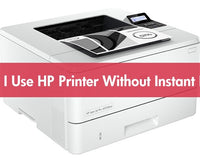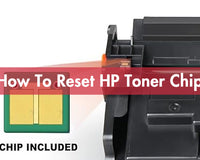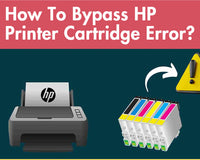Printer ink drying out is a common annoyance, often resulting in wasted cartridges and costly replacements. But why does this happen? From improper storage to infrequent use, various factors can lead to dried-out ink. In this blog, we will explore the reasons behind printer ink drying out and provide practical solutions to help you keep your printer running smoothly. Read on to learn how to extend the life of your ink cartridges and avoid unexpected printing headaches.
What Type Of Printer Cartridge Will Dry?
Printer cartridges can be broadly categorized into ink cartridges and toner cartridges.
- Ink Cartridges: used in inkjet printers and contain liquid ink. These cartridges are highly susceptible to drying out if not used regularly. The ink in these cartridges is dispensed through tiny nozzles onto the paper. When an inkjet printer is not frequently used, the ink in the nozzles can evaporate and dry up, causing clogs. Dye-based inks, in particular, dry out faster than pigment-based inks.
- Toner Cartridges: used in laser printers, contain powdered toner. Unlike ink cartridges, toner cartridges do not dry out because the toner powder does not evaporate. It makes toner cartridges much more stable over long periods of inactivity. Consequently, laser printers are a better option for people who print infrequently, as they do not face the issue of dried-out cartridges.

Root Causes And Solutions of Printer Ink Drying Out
This ink issue can be frustrating, but understanding the causes can help you prevent it in the future. Here are five common reasons why printer ink dries out and corresponding solutions for them:
1. Infrequent Use and Regular Printing
- Cause: The most common reason for printer ink drying out is infrequent use. When a printer sits idle for extended periods, the ink in the cartridges can dry up, clogging the print heads and nozzles.
- Impact: This can lead to streaky prints, incomplete images, and the printer failing to recognize the cartridge.
- Solution: To prevent ink from drying out, it is essential to use your printer regularly. Even if you don't need to print frequently, printing a small test page every few days can help keep the ink flowing and prevent clogs.
- Tip: Set a reminder to print a test page at least once a week to ensure the ink stays fresh.
2. Environmental Factors and Maintaining Optimal Conditions
- Cause: Environmental conditions, such as high temperatures and low humidity, can cause ink to evaporate more quickly. Exposure to direct sunlight can also contribute to this issue.
- Impact: These factors can accelerate the drying process, leading to clogged nozzles and reduced print quality.
- Solution: Keep your printer in a controlled environment, away from direct sunlight, high temperatures, and low humidity. If necessary, use a humidifier to maintain an optimal humidity level around your printer.
- Tip: Aim for a humidity level between 40-60% to prevent ink from drying out too quickly.
3. Expired Ink Cartridges and Using Expiry Dates as a Guide
- Cause: Ink cartridges have a shelf life, and using them beyond their expiration date can result in dried-out ink. The chemical composition of the ink can change over time, making it more prone to drying.
- Impact: Expired ink cartridges may cause poor print quality and potential damage to the printer's print head.
- Solution: Pay attention to the expiration dates on your ink cartridges and try to use them before they expire. Using fresh ink can prevent drying and ensure the best print quality.
- Tip: Rotate your stock of ink cartridges, using the oldest ones first to avoid having expired cartridges on hand.
4. Poor Cartridge Storage and Proper Storage
- Cause: Improper storage of ink cartridges, such as exposure to air or improper sealing, can lead to drying out. Cartridges stored in extreme temperatures or humidity levels are particularly vulnerable.
- Impact: This can cause the ink to dry prematurely, leading to clogged print heads and nozzles.
- Solution: Store your ink cartridges in a cool, dark place with consistent temperature and humidity levels. Ensure the cartridges are sealed correctly to prevent exposure to air.
- Tip: Keep unopened cartridges in their original packaging until you are ready to use them.
5. Low-Quality Ink and Using High-Quality Ink
- Cause: Low-quality or counterfeit ink cartridges often contain inferior ink formulations that are more prone to drying out. These inks may lack the necessary additives to prevent evaporation and clogging.
- Impact: Using low-quality ink can result in frequent drying, poor print quality, and potential damage to the printer.
- Solution: Invest in a high-quality, manufacturer-recommended brand like True Image. These cartridges are formulated to work best with your printer and are less likely to dry out prematurely.
- Tip: Whether you buy Brother, Canon, Epson, or HP ink cartridges, choose to purchase them from an official store or a reliable supplier.
|
True Image Premium Ink Cartridges
|
|
|
HP Ink Cartridges |
HP 912 (BK: 300 pages; CYM: 315 pages); HP 912XL (KCYM: 825 pages) |
|
HP 963 (BK:1,000 pages; CYM:700 pages); |
|
|
Brother Ink Cartridges |
Brother LC421 (KCYM: 200 pages); Brother LC421XL (KCYM: 500 pages) |
How To Fix Dried-Out Printer Ink Cartridges?
Avoiding your printer ink drying out ensures long-lasting performance and high-quality prints. Here are some extended tips on keeping your printer in top condition:
1. Cleaning Print Heads Regularly
Regularly cleaning print heads is essential to prevent ink buildup and clogs that can affect print quality. Most printers are equipped with a built-in cleaning function, accessible through the printer's software or control panel. You can run the cleaning cycle at least once a month or whenever you notice a decline in print quality, such as streaks or missing lines.
2. Using Printer Maintenance Tools
Modern printers come with a variety of maintenance tools and utilities designed to keep the printer in optimal condition. These tools can run diagnostics, clean print heads, align cartridges, and perform other essential maintenance tasks. Regular use of these utilities can prevent many common issues and extend the life of your printer.
3. Turning Off the Printer Properly
Properly turning off your printer when not in use is crucial for maintaining print head health. Using the power button rather than unplugging the printer ensures that the print heads are correctly capped, which prevents them from drying out due to air exposure. If you won't be using the printer for an extended period, consider removing the unused ink cartridges and storing them in a sealed container.
















